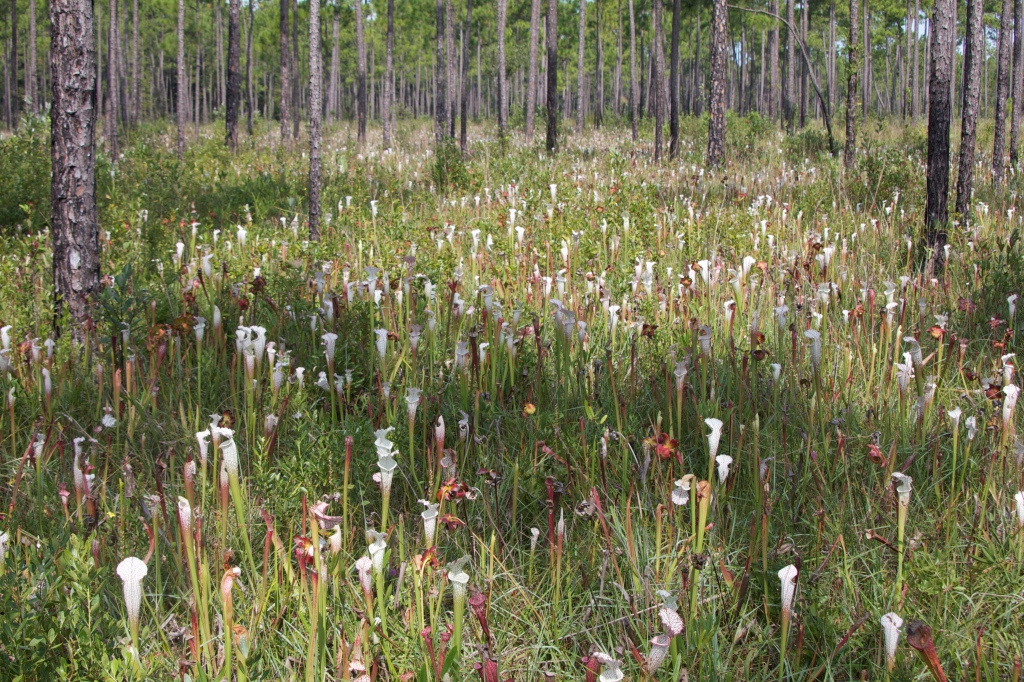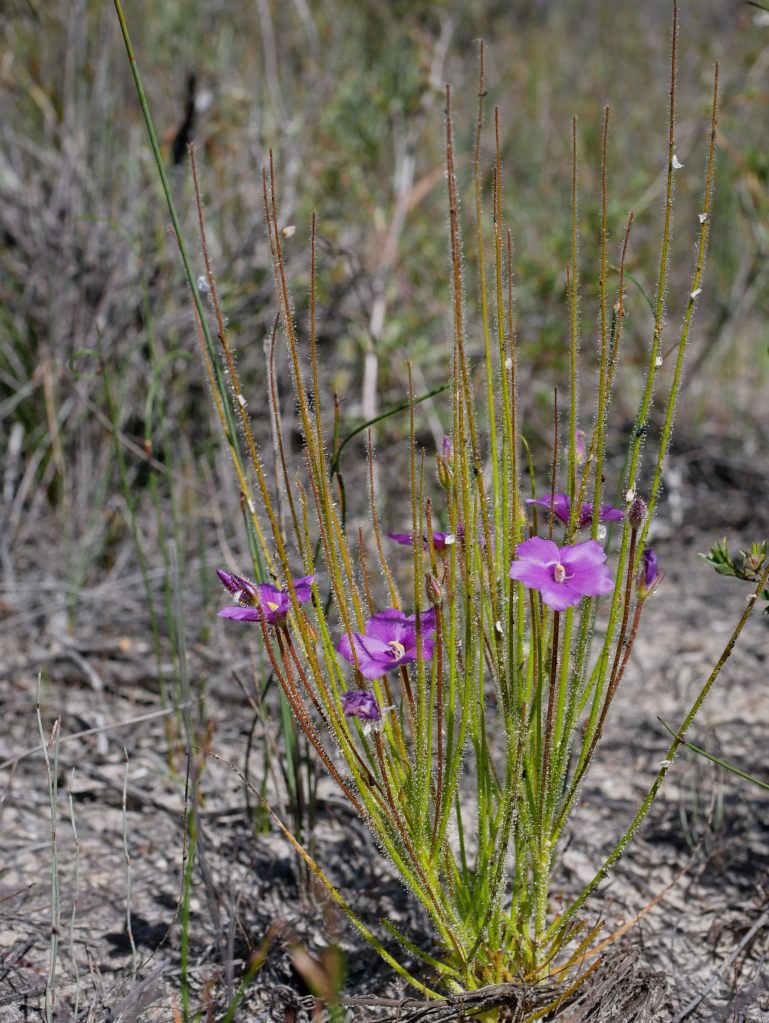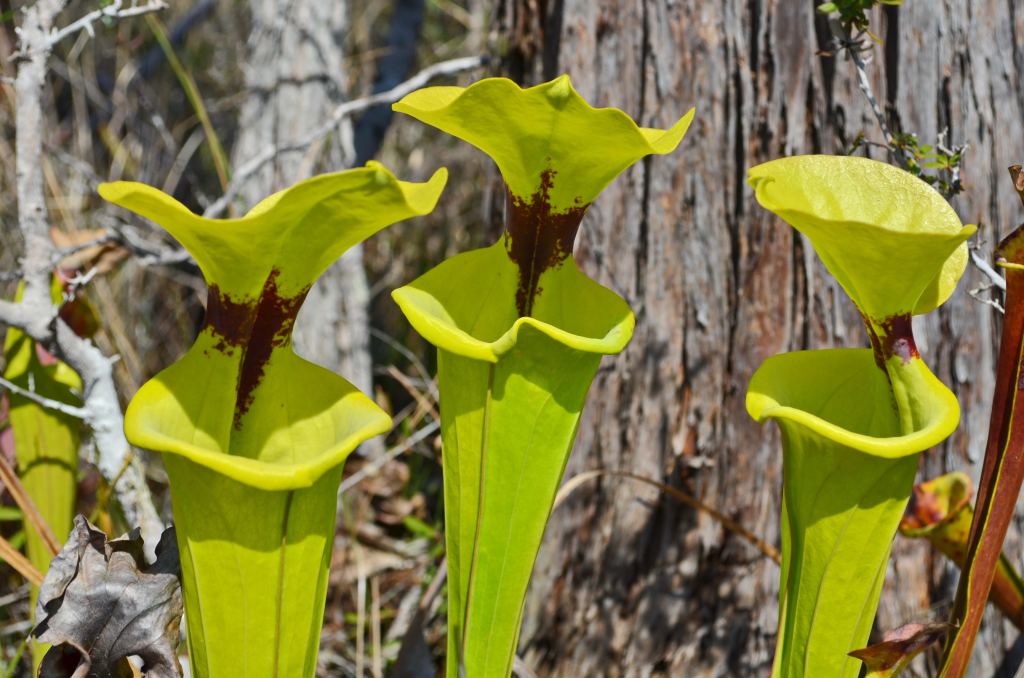Adam Cross and Thilo Krueger describe the natural history and conservation of carnivorous plants. Adam is a research fellow at Curtin University , Western Australia and Science Director for the EcoHealth Network. Thilo is a masters student in Adam’s research group and is researching prey spectra and other plant-animal interactions of carnivorous plants.
Carnivorous plants are a unique and fascinating group that have captivated scientists and the public, as well as inspired writers and film makers, for well over a hundred years. During his seminal 1875 work Insectivorous Plants, while studying one of the sticky-leaved Sundews (Drosera), British naturalist Charles Darwin once famously and not at all exaggeratedly wrote “I care more about Drosera than the origin of all the species in the world”. These incredible species have flipped the traditional perception of plants as immobile producers, and possess highly modified leaves that have evolved to attract, capture and digest animal prey – mostly small insects, but for some species occasionally also birds and small mammals.

Capturing prey allows carnivorous plants to obtain nutrients in habitats where soils are extremely nutrient-poor, and they thrive in areas like swamps, rocky seepages and dripping rock walls, seasonally-flooded lowlands and even the canopies of tropical rainforests. Many species of these predatory plants grow in almost pure sand or in laterite soils, which are notoriously low in important nutrients for plants such as nitrogen and phosphorus. In these habitats, carnivory represents a very effective strategy for competition and survival.

While there are several very well-known carnivorous plants, such as the Venus Flytrap (Dionaea) and Trumpet Pitcher Plants (Sarracenia) of North America, there are in fact over 860 species that are currently described world-wide. Incredibly, carnivory has independently evolved at least 11 times in different plant lineages, and at many different points in time. This evolutionary development has led to a wide diversity not only in the size and form or carnivorous plants, but also their function and biology. While some species are not much larger than a single grain of sand (such as the diminutive Utricularia simmonsii, one of the smallest of all flowering plants), the largest species are vines growing up to 60 m into rainforest canopies (Triphyophyllum peltatum). Many species are terrestrial, occurring in habitats ranging from mountain tops to Mediterranean scrubland to seasonally-wet swampland, and numerous species have become partially or even fully aquatic. Within tropical rainforests, there are even a number of epiphytic carnivorous plants – species growing high in the canopy on the mossy trunks or branches of trees.

However, perhaps most incredibly, there are many different structures and methods that plants have evolved for carnivory. A range of genera, including Byblis (Byblidaceae), Drosera (Droseraceae), Drosophyllum (Drosophyllaceae), Pinguicula (Lentibulariaceae) and Triphyophyllum (Dioncophyllaceae) employ sticky leaves to capture prey, relying upon mucilage produced by specialized sessile or motile glands containing digestive enzymes to snare and absorb nutrients from insects. Philcoxia (Plantaginaceae) also produces sticky leaves, but holds these beneath the soil surface to capture small nematodes and other small subterranean fauna. Some species produce leaves modified to form pitchers of varying complexity with slippery walls to prevent the escape of captured prey, which drown and are digested in pools of water and enzymes (Brocchinia and Catopsis [Poaceae], Cephalotus [Cephalotaceae], Nepenthes [Nepenthaceae], and Darlingtonia, Heliamphora, Sarracenia [Sarraceniaceae]). Still others utilize quick-moving, snapping lobed traps (Dionaea and Aldrovanda [Droseraceae]), and many species even produce highly complex subterranean corkscrew and suction traps (Genlisea and Utricularia [Lentibulariaceae]). Some of these structures are capable of making among the fastest movements in the plant kingdom.

A number of carnivorous plants also exhibit amazing biological mutualisms, being rather paradoxically reliant upon animals for their growth and survival. Roridula (Roridulaceae) produces sticky resin from glands on its leaves, but lacks the capability to produce any digestive enzymes and instead relies upon a unique digestive mutualism with a Hemipteran bug (Pameridea species) to absorb nutrients from captured prey, as these bugs can move among the resinous glands without being captured and defecate onto the leaf surface. Similar digestive mutualisms are known for Hemipteran bugs of the genus Setocoris with Byblis and some species of Drosera. The digestive fluid of the pitcher plant Cephalotus follicularis provides crucial breeding habitat for a species of stiltfly (Badisis ambulans), while Nepenthes hemsleyana provides a safe roosting site for Hardwicke’s bat and in return benefits from digesting the ablutions of roosting bats in addition to capturing insect prey. Other Nepenthes, such as the Bornean N. lowii, produce an appealing food for tree shrews on the underside of the pitcher lid, which has a laxative effect and results in the shrew depositing a package of nutrients into the pitcher ‘latrine’ in return for the feed. It has even been proposed that the squat pitchers of Nepenthes ampullaria, which are open to the rain and catch falling leaf detritus, could be vegetarian.

These predatory plants can be found on every continent except Antarctica, but there are distinct “hotspots” of carnivorous plant diversity in South America, South Africa, Southeast Asia and Australia. Almost a quarter of all currently described carnivorous plants can be found in the ancient, nutrient-poor landscapes of Western Australia, for example. Unfortunately, many of these areas are also experiencing some of the world’s highest rates of habitat destruction – in the southwest of Western Australia, where approximately 120 species of carnivorous plants occur, approximately 70% of all native vegetation (and up to 97% in some regions) has been cleared for agriculture and urban development. What little native vegetation remains is often isolated, heavily fragmented, and significantly degraded from weed invasion and poor fire management.
Carnivorous plants have been described as harbingers of ecosystem integrity, as they are often the first to disappear after disturbance. As might be expected given their unique ecologies, most carnivorous plants have very small ecological niches and are extremely sensitive to environmental change. Given that they often rely on habitats such as nutrient-poor wetlands, which are particularly vulnerable to human impacts and represent some of the most threatened ecosystems globally, carnivorous plants face an existential threat in the 21st Century.

A recent international study by Cross et al. (2020) examining the conservation status and threats faced by carnivorous plants found approximately a quarter of all species around the world were at risk of extinction. The highest numbers of critically endangered species occurred in Australia, Brazil, Indonesia, Philippines, Cuba and Thailand – in many cases, the same areas regarded as the most significant hotspots of carnivorous plant diversity. Importantly, 89 species of carnivorous plants (over 10% of all species) are only known from a single location, making them particularly vulnerable to any disturbances, and particularly rapid impacts, to their habitats.

Due to their unique insect-capturing traits and often spectacular appearance, many carnivorous plants are very popular with horticulturists and hobby plant collectors. Unfortunately, this has created a significant market for illegal collection – also known as poaching – of carnivorous plants and several species have already been driven to the brink of extinction by poachers. Pitcher Plants such as Tropical Pitcher Plants from south-east Asia and the Albany Pitcher Plant from Western Australia are particularly affected by poaching but even the iconic Venus Flytrap from the United States continues to be plagued by unscrupulous poachers. There must be immediate and concerted global action to cease the illegal collection of wild plants, and much greater regulatory enforcement of biodiversity protection laws to end carnivorous plant poaching.

Cross et al. found that the continuing clearing of natural vegetation for agriculture, urban development and mining projects represented by far the most severe and immediate threat to carnivorous plants. In just the past two decades, massive areas of pristine habitat have been converted into oil palm plantations in Southeast Asia, cattle farms in Brazil, or suburban housing and industrial development in Australia. For example, two of the last remaining populations of the Critically Endangered rainbow plant (Byblis gigantea) in Perth, Western Australia, were destroyed for the construction of a liquor supermarket and a logistics distribution centre. Several populations of sundews (Drosera) near the town of Hermanus, in South Africa, are rather paradoxically being lost to the development of a settlement known as “Sundew Villas”. Much stronger protections are required to ensure that remnant carnivorous plant habitats are protected and conserved.

Climate change poses another significant threat to carnivorous plants, especially the many species occurring in Mediterranean climate regions where warming, drying trends are already becoming evident. Extreme and prolonged drought conditions, such as have been recently experienced in many Mediterranean climate regions around the world, can not only impact directly upon species and communities, they can also fuel high-intensity and aseasonal fires. Although fire forms a natural part of the ecology of many ecosystems in which carnivorous plants occur, fire regimes have been increasingly altered by climate change and inadequate fire management practices. The effect of altered fire regimes on carnivorous plants is complex, idiosyncratic and often still poorly understood; while some species (especially geophytes such as tuberous Drosera) may benefit from high-intensity fires that remove competition from other vegetation, the same fire can have devastating impacts on other species lacking underground structures for resprouting. For example, an extreme summer bushfire in 2006 near Perth, Western Australia, fuelled by record drought conditions at the time, reduced the only known population of the critically endangered Drosera leioblastus from several thousand individuals to just 11 plants, while simultaneously inducing mass-flowering of most tuberous Drosera in the same area. The complex effect of fire and the need for sound fire management policies is highlighted by the Albany Pitcher Plant (Cephalotus follicularis), which is threatened both by prescribed burning at short fire intervals as well as long-term fire suppression. Weed invasion can further exacerbate fire management, and Cross et al. (2020) suggest that simultaneous prioritisation should be afforded to invasive species management and the maintenance and preservation of natural ecosystem processes such as fire regimes and hydrological functioning.

Ecological restoration offers not only hope for the return of many carnivorous plant species to regions from which they have been lost, but also an effective mechanism by which ecosystem functioning and natural processes like fire and hydrology can be reinstated in degraded landscapes where these processes have been impaired. While there is growing urgency to conserve what little natural carnivorous plant habitat remains, Cross et al. (2020) highlight the growing imperative to begin scaling up restoration efforts in areas where habitat loss and ecosystem disturbance have been most severe, in order to concomitantly provide new habitat for these species and provide buffers for protected areas. Far too often remnant habitats are not only highly fragmented but also abut farmland or urban developments, and the restoration of ecological corridors and buffer zones will confer resilience and greater ecological integrity to these increasingly beleaguered ecosystems.
The loss of carnivorous plants would not only be a devastating loss for future generations, but could potentially have detrimental effects across ecosystems. They have captivated scientists and the public for hundreds of years, from their portrayal as horrifying monsters in popular films to providing inspiration for the development of non-stick surfaces. But they are integral parts of ecosystems, important cogs in the complex biodiverse systems in which we live and upon which we rely, and we must preserve them. The number of vulnerable, endangered and extinct species continues to grow despite conservation efforts around the world, and it is clear that we must begin investing significantly in the restoration of carnivorous plant habitats, particularly in regions such as Australia, Brazil, South Africa, southeast Asia and North America, if they are to survive for future generations to marvel at.

Our global review of the conservation status of carnivorous plants can be read in full, open access, here. To learn more about the unique and incredible biology of our carnivorous plant heritage, see a recent international monograph about their ecology, biology and evolution to which the present authors were contributors. The authors have also recently written books on some of the most amazing carnivorous plant species, including the Waterwheel Plant, Aldrovanda vesiculosa and the Albany Pitcher Plant, Cephalotus follicularis.